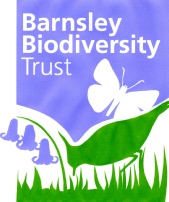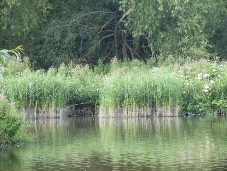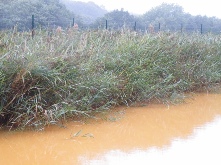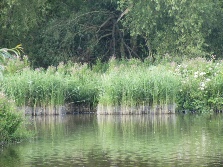





Reedbeds and wetlands. The network of reedbeds and wetlands in Barnsley is an important local feature, with the Dearne Valley becoming nationally significant.
They are some of the richest areas for dragon and damselflies and other invertebrates, amphibians, birds such as the nationally rare Bittern, and mammals such as Water Vole and Harvest Mouse.
Reedbed and swamp habitats.
Wetlands that are normally flooded throughout the year give rise to swamp with tall reed grasses such as common reed, reedmace and reed canary grass, emerging from the water.
Although all forms of wetland habitat support wildlife, the most significant is reedbed - swamp dominated by common reed Phragmites australis - with its distinctive range of breeding birds including the nationally rare bittern.
There are a number of reedbeds in Barnsley in river valley situations, in former colliery lagoons, or planted for water treatment, including mine water.
The largest reedbed in the area is at RSPB Old Moor and Bolton Ings (>12 ha). Reedbed areas are also to be found at Worsbrough reservoir (2 ha), Park Hill (5-8 ha) and Carlton Marsh Nature Reserve with smaller examples (<1 ha) at Grimethorpe, Rabbit Ings, and Royston Canal.
Reedbed
Reedbed, large or small areas of swamp dominated by common reed, is local priority habitat.
Reedbed falls within the UK BAP broad habitat category Fen, Marsh and Swam
Reedbed over 20ha in size is a UK priority habitat.
Reedbed is classed as swamp in phase 1 habitat surveys
The National Vegetation Classification (NVC) for reedbed is S4 Common reed swamp.
Other related NVC communities are listed within the the swamp & tall herb-fen NVC plant communities, and include S12 reedmace swamp, S28 reed canary grass fen.
The best examples support species of high conservation importance, such as bittern; or support good populations or assemblages of key species such as water vole, amphibians, dragon or damselflies; or provide a rich site for wetland plants or invertebrates.
Some priority species depend on larger reedbeds and such reedbeds or groups of reedbeds - or those capable of being extended are important for this reason.
The best habitat sites should be protected and conserved; others should be retained if viable and improved. However some wetland vegetation can be invasive and care should be taken to prevent other valuable habitat being lost.



Species supported in Barnsley by reedbeds and wetland habitat
Bird: Bittern has overwintered and bred. Cetti’s warbler has attempted to breed.
More common breeding birds include reed bunting and reed & sedge warblers.
Marsh harrier has visited reedbeds for foraging. Wetlands and especially reedbeds  provide roosting sites for migratory species like swallow, and for several raptor species in winter.
provide roosting sites for migratory species like swallow, and for several raptor species in winter.
Waders are also supported.
Amphibian: Great Crested Newt, other newts, frogs, toad all benefit from reedbed and wetland habitat.
Reptile: Grass snake
Mammal: Reedbeds are also important for water voles as well as harvest mouse, some bats and otter
Invertebrates: Several Red Data Book invertebrates are also closely associated with reed-beds including damsel and dragonflies and moths like the locally rare Fen Wainscot Moth.
The criteria for selection as a local wildlife site on the basis of wetland habitat includes
- reedbeds ≥25ha and a good assemblage of wetland plant species
or that regularly support any of the following:
- a colony of Water Vole
- a good population of Great Crested Newt pr assemblage of amphibians
- a good assemblage of Dragonfly or Damselfly species breeding in the water body.
or buffers other priority habitats such as Ponds and Rivers and Streams.
The creation and extension of reedbed in the wetlands of the Dearne Valley has led to breeding bittern at RSPB Old Moor.

Roles
Landowners including Barnsley Council, the Environment Agency, the RSPB, private estates, trusts, and individuals: seek to manage reedbed habitat, following best practice.
They can also take up opportunities to restore or create reedbeds and connecting habitats where this does not damage other habitats.
The RSPB, Environment Agency and others are creating and extending reedbeds at Bolton Ings and elsewhere in the Dearne Valley as part of the NIA and flood defence work.
A number of organisations including land fill bodies may offer grants for reedbed creation and improvement
Barnsley council as a planning authority can ensure in relevant cases that the biodiversity value of reedbeds are maintained and enhanced. It can set conditions to protect reedbeds and require EIAs where appropriate.
Voluntary groups and volunteers can help with reedbed creation, extension and management where appropriate.
Local groups and volunteers can help provide information about the condition of our reedbeds and collect records of the wildlife seen there.
Factors causing loss or decline in quality of reedbed habitat
Lack of, or inappropriate, management, of existing reedbeds leading to drying out, scrub encroachment, and succession to woodland. Positive management requires winter cutting of reeds in rotation.
Reedbeds have been lost to water abstraction and drainage, and intensive agriculture.
Pollution of freshwater feeding reedbeds; siltation leading to drying out, toxic chemicals may cause loss of fish and amphibian prey for key species and accumulation of poisons in the food chain and eutrophication may cause reed death.
Good practice in managing reedbeds
Keep the water levels of reedbeds, swamps, mires and marshes at reasonably stable and appropriate seasonal levels. Areas of open water should be kept in reedbeds.
Reed may invade and smother mixed fen, marsh or wet grassland which has its own value for biodiversity. This should be avoided. Grazing may help.
Regular management helps reedbed habitat. Cutting reeds in different areas in a four to seven year rotation prevents the build-up of nutrients and dead plant material.
Maintain all stages of succession from young reed in shallow water to old reed with scrub on almost dry ground over dense litter.
Removing reeds to prevent decomposition, build up of litter, and nutrient-enrichment, and to keep some reed young and healthy. Removal of litter prevents or slows drying out of reed bed.
However some areas where reed is not cut regularly should be also be left and allowed to form a deep litter layer. It is important to have some areas of litter that will be kept moist and not dry out completely.
Scrub encroachment should be discouraged over most of the reedbed area, but in some small areas scrub should be retained.
Maintain links with other wetland and non-wetland habitats. Flower-rich areas at the margin of the reedbeds should be encouraged to provide pollen and nectar sources for adult insects.
Reed may invade and smother mixed fen, marsh or wet grassland which has its own value for biodiversity. This should be avoided. One means of control is to deploy cattle grazing.
Storing cut reeds on site should be avoided since it can cause localised nutrient enrichment and decreased plant diversity/water quality.
Sloping edges at the edge of the reedbed support wildlife during both summer drawn-down and at times of unusually high water levels.
Our key objectives for biodiversity in reedbeds must be to:
- Raise awareness of the importance of reedbed habitat for biodiversity
- Review the extent and condition of reedbed habitat in Barnsley.
- Promote good reedbed management practice for identified reedbeds and seek to maintain the extent of reedbed habitat
- Seek the creation of new reedbed habitat and extension of existing reedbed habitat
- Seek to create links and corridors between reedbeds and other wetland habitat sites
- Collect and analyse records of populations and assemblages of wildlife species in reedbeds across Barnsley
- Ensure that all suitable reedbed sites are identified as Local Wildlife Sites or SSSIs
More specifically…
- Monitor the reedbed restoration at Worsbrough reservoir and carry out further works as appropriate (Barnsley Council)
- Continue to create new areas of reedbed on suitable sites in the Dearne valley including opportunities provided by flood defence work (RSPB, Environment Agency)
- Continue to release elvers into Dearne valley reedbeds and involve the public and schools in the process (RSPB, Don River Trust)
- Survey reedbeds for the presence of grass snake and harvest mouse and advise appropriate management.
- Collect and analyse records of populations and assemblages in reedbeds of breeding cuckoo and reed bunting (RSPB, BBSG, BBRC)
Reedbed and other wetland habitat and wildlife species:
Reedbed and other swamp habitat is beneficial to the greatest number of species when it includes a range of features, for example, open water, pools and water edges for the invertebrates and birds, rotting leaf-litter for Grass snake.
The reedbed fringes, often extending into areas of Reed canary grass, are important for Grass snake and for Harvest mouse. In fact Reed canary grass, preferring slightly drier conditions, may provide a corridor habitat along the edges of ditches and dykes where Harvest mouse in particular may flourish.
Grasshopper warbler and Cettis warbler nest in drier mixed areas with associated carr scrub.
The ideal to support all types of wildlife is to have all the stages of succession from young reed in shallow water to old reed with scrub invasion on almost dry ground over dense litter. This requires regular management of the reedbed by cutting reeds in rotation.
The mown area is good for snipe, redshank and mallard; the dense wet reedbed with little litter and high seed production supports bittern, marsh harrier, and reed warbler; old reed with a dense litter layer benefits bearded tit, sedge warbler and marsh harrier; whilst maintaining open water / dykes and encouraging a diversity of marginal plants benefits a range of wetland birds.
A good number of species, for example otter and marsh harrier, need links with other habitats including wet grassland and carr woodland.
Bittern, marsh harrier and bearded tit are said to require reed beds 20ha in size. Locally however smaller reedbeds have supported breeding bittern. Other species are supported by much smaller areas of reedbed as well as by other swamp, fen and marsh habitats.
Status
There is only about 5000 ha of reed beds in the UK, but of the 900 or so sites contributing to this total, only about 50 are greater than 20 ha
Conservation action for reedbeds across the country over the last 20 years has been highly successful in restoring large areas of reedbed and the creation of over 1,000 hectares of new reedbed is in progress. The work of the RSPB in the Dearne Valley is making a significant contribution.
Legal protection.
n Barnsley there are some sites given legal protection by being within areas designated as SSSIs or as Local Nature Reserves - Dearne Valley country park,
Other sites in Barnsley are in areas designated as local wildlife sites and therefore there is a presumption against development or change of use that would have an adverse effect on their conservation value when planning consent is required,including change of land use.
Specific wildlife species of reedbeds and other wetland habitats are protected under the Wildlife and Countryside Act including intentionally or recklessly disturbing birds at, on or near an ‘active’ nest.
Defra Ecological Impact Assessments apply to reedbeds.
2 Whitley Edge
4 Ingbirchworth Reservoir
5 Royd Moor Reservoir
7 Small Shaw & High Bank
10 Hollin and Spring Woods
11 Gunthwaite Dam/Clough Wood
18 Mag Wood Meadow
22 Stainborough Park
24 Worsbrough Reservoir
25 Barnsley Canal at Wilthorpe
26 Cliffe Wood
27 Carlton Marsh
28 Stairfoot Disused Railway
29 Wombwell Wood
30 Short Wood & Hay Green
35 Edderthorpe Ings
36 Broomhill Flash & Wombwell Ings
37 Gipsy Marsh
38 Old Moor & Wath Ings (reedbed)
39 Bolton-on-Dearne wetland (reedbed)
40 Forge & Tin Mill Rocher
46 Elsecar Reservoir
48 Bretton Park
49 Barnsley Canall at Royston (reedbed)
51 Barrow Colliery
54 Old Mill Lane Culvert Bat Roost
55 Parkhill Nature Reserve
57 Swaithe Flood Meadows
Local Wildlife sites that include swamp habitats
Other reedbed habitat not designated as a local wildlife site include:
- Rabbit Ings
- Grimethorpe
- Adwick washland
We welcome your comments
Your email address will not be public.